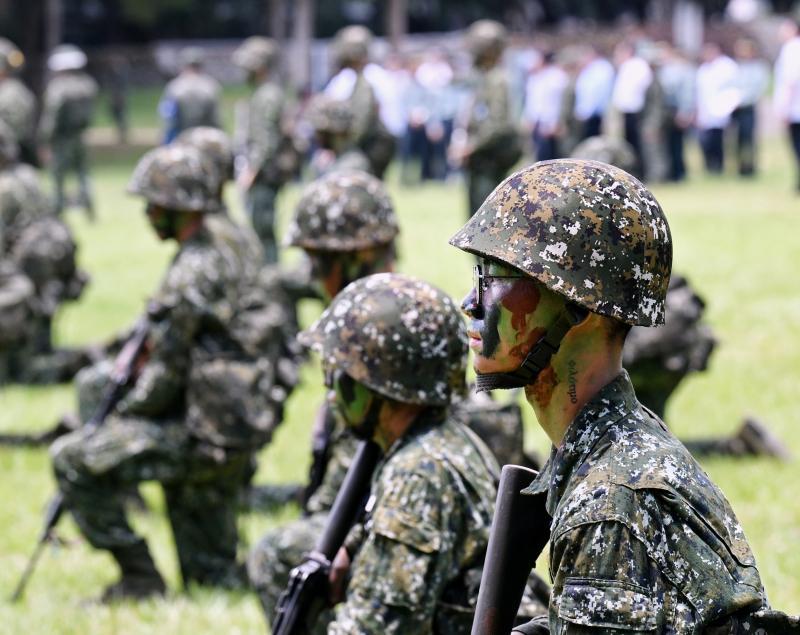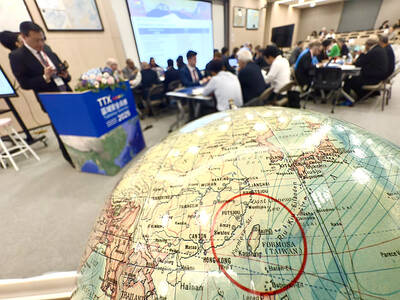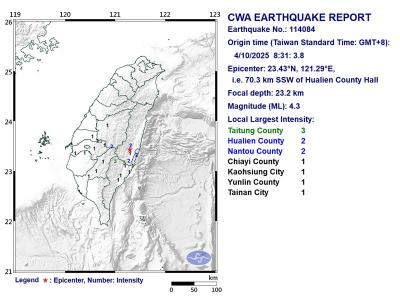The Ministry of National Defense (MND) today delivered its Quadrennial Defense Review (QDR) to lawmakers, highlighting the nation’s defense strategy and elaborating on the role of US military cooperation.
As per Article 31 of the National Defense Act (國防法), the ministry must publicly submit the QDR to the Legislative Yuan within 10 months of a presidential inauguration.
The Legislative Yuan’s Foreign and National Defense Committee invited Minister of National Defense Wellington Koo (顧立雄) to deliver the review and answer questions from lawmakers.

Photo: Fang Pin-chao, Taipei Times
The previous QDR in 2021 focused on strong defenses and multi-layered deterrence, which remained unchanged in this iteration.
The strategy would take advantage of Taiwan’s terrain to develop military preparation around the principles of “adaptability, agility, lethality, cost-effectiveness and stealth,” the latest QDR said.
The nation would build combat capability across land, sea and air, in addition to cyber, to deter aggression, the QDR said.
In wartime, the ministry would rapidly mobilize, enact multiple layers of defense and lean on military-civilian integration to delay enemy actions, weaken any invading forces and force a retreat, it said.
Future budget increases would focus on enhancing asymmetric capabilities and strengthening counters to “gray zone” threats, the QDR said.
To bring the total defense budget to President William Lai’s (賴清德) target of more than 3 percent of GDP, the MND would prioritize a special defense budget, it added.
Unlike the previous QDR in 2021, the latest review included a separate chapter dedicated to “linking regionally to strengthen collective deterrence,” with the chapter’s first section dedicated to “deepening military exchanges between Taiwan and the US.”
The US is an important strategic partner, engages in close military exchanges and assists the nation in developing its self-defense capabilities, it said.
The ministry would continue to promote strategic cooperation with the US to maintain peace and stability in the Taiwan Strait, it added.
As for future cooperation plans, the ministry would expand and deepen cooperation in strategic national security dialogues and visits, joint military exercises, defense industry cooperation and intelligence sharing, it said.

Taiwan is stepping up plans to create self-sufficient supply chains for combat drones and increase foreign orders from the US to counter China’s numerical superiority, a defense official said on Saturday. Commenting on condition of anonymity, the official said the nation’s armed forces are in agreement with US Admiral Samuel Paparo’s assessment that Taiwan’s military must be prepared to turn the nation’s waters into a “hellscape” for the Chinese People’s Liberation Army (PLA). Paparo, the commander of the US Indo-Pacific Command, reiterated the concept during a Congressional hearing in Washington on Wednesday. He first coined the term in a security conference last

DEFENSE: The National Security Bureau promised to expand communication and intelligence cooperation with global partners and enhance its strategic analytical skills China has not only increased military exercises and “gray zone” tactics against Taiwan this year, but also continues to recruit military personnel for espionage, the National Security Bureau (NSB) said yesterday in a report to the Legislative Yuan. The bureau submitted the report ahead of NSB Director-General Tsai Ming-yen’s (蔡明彥) appearance before the Foreign and National Defense Committee today. Last year, the Chinese People’s Liberation Army (PLA) conducted “Joint Sword-2024A and B” military exercises targeting Taiwan and carried out 40 combat readiness patrols, the bureau said. In addition, Chinese military aircraft entered Taiwan’s airspace 3,070 times last year, up about

A magnitude 4.3 earthquake struck eastern Taiwan's Hualien County at 8:31am today, according to the Central Weather Administration (CWA). The epicenter of the temblor was located in Hualien County, about 70.3 kilometers south southwest of Hualien County Hall, at a depth of 23.2km, according to the administration. There were no immediate reports of damage resulting from the quake. The earthquake's intensity, which gauges the actual effect of a temblor, was highest in Taitung County, where it measured 3 on Taiwan's 7-tier intensity scale. The quake also measured an intensity of 2 in Hualien and Nantou counties, the CWA said.

The Overseas Community Affairs Council (OCAC) yesterday announced a fundraising campaign to support survivors of the magnitude 7.7 earthquake that struck Myanmar on March 28, with two prayer events scheduled in Taipei and Taichung later this week. “While initial rescue operations have concluded [in Myanmar], many survivors are now facing increasingly difficult living conditions,” OCAC Minister Hsu Chia-ching (徐佳青) told a news conference in Taipei. The fundraising campaign, which runs through May 31, is focused on supporting the reconstruction of damaged overseas compatriot schools, assisting students from Myanmar in Taiwan, and providing essential items, such as drinking water, food and medical supplies,